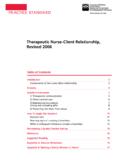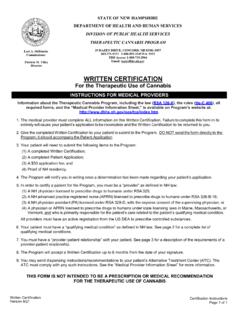Transcription of Diagnostic and Therapeutic Injection of the SHoulder ...
1 MARCH15, 2003 / VOLUME67, of ligaments and muscles, includingthe four muscles of the rotator cuff (supra-spinatus, infraspinatus, teres minor, and sub-scapularis) that serve as dynamic stabilizers ofthe joint. Static stabilizers include the jointcapsule, the glenoid labrum, and the gleno-humeral AND DIAGNOSISJ oint Injection in this area should be con-sidered only after other appropriate therapeu-tic interventions have been tried. Theseinclude the use of nonsteroidal anti-inflam-matory drugs (NSAIDs), physical therapy, andother disease-modifying agents for rheuma-toid arthritis.
2 There are three major indica-tions for a glenohumeral joint Injection :osteoarthritis, adhesive capsulitis (frozenshoulder),5-14and rheumatoid of the SHoulder typicallyoccurs in older persons or following trau-matic injury in younger persons. Patientsusually present with chronic pain, decreasedrange of motion, and accompanying weak-ness. Although radiographs can assist in thediagnosis, findings do not always correlatewith clinical symptoms or functioning. Adhe-sive capsulitis is a condition typically occur-ring in middle-aged and older adults, and it isThis article, the third in a series ondiagnostic and Therapeutic in-jections, covers the SHoulder re-gion.
3 The rationale, indications,contraindications, and generalapproach to this technique are covered in thefirst article1in this series published in the July15, 2002 issue. The SHoulder is the site of mul-tiple injuries and inflammatory conditionsthat lend themselves to Diagnostic and thera-peutic article covers theanatomy, pathology, diagnosis, and injectiontechnique of common sites in which this skillis JointThe glenohumeral joint represents thearticulation of the humerus with the glenoidfossa, and it is the most mobile joint in thebody.
4 The glenohumeral joint is not a trueball and socket joint. The articulation is stabi-lized by the soft tissue configurations of aThe SHoulder is the site of multiple injuries and inflammatory conditions that lend them-selves to Diagnostic and Therapeutic Injection . Joint Injection should be considered afterother Therapeutic interventions such as nonsteroidal anti-inflammatory drugs, physicaltherapy, and activity- modification have been tried. Indications for glenohumeral joint injec-tion include osteoarthritis, adhesive capsulitis, and rheumatoid arthritis.
5 For the acromio-clavicular joint, Injection may be used for diagnosis and treatment of osteoarthritis and dis-tal clavicular osteolysis. Subacromial injections are useful for a range of conditionsincluding adhesive capsulitis, subdeltoid bursitis, impingement syndrome, and rotator cufftendinosis. Scapulothoracic injections are reserved for inflammation of the involved pain related to inflammatory conditions of the long head of the biceps respondswell to Injection in the region. The proper technique, choice and quantity of pharmaceuti-cals, and appropriate follow-up are essential for effective outcomes.
6 (Am Fam Physician2003;67:1271-8. Copyright 2003 American Academy of Family Physicians.)The major indications for glenohumeral joint injectioninclude osteoarthritis, adhesive capsulitis (frozen SHoulder ),and rheumatoid and Therapeutic Injectionof the SHoulder RegionALFRED F. TALLIA, , , and DENNIS A. CARDONE, , , University of Medicineand Dentistry of New Jersey Robert Wood Johnson Medical School, New Brunswick, New JerseyOFFICE PROCEDURESThis article is one in aseries of Office Proce-dures articles coordi-nated by Dennis , , , associateprofessor, and Alfred , , ,associate professor,Department of FamilyMedicine, UMDNJ Robert Wood JohnsonMedical School, NewBrunswick, New associated with a traumatic injury ornonuse of the SHoulder secondary to pain,discomfort.
7 Or prolonged condition is more common in womenand persons with is oftenaccompanying tendinosis or arthritis is a systemic inflamma-tory disease of autoimmune nature thatinvolves inflammation of the synovium of theshoulder of glenohumeral joint pathologyis suspected clinically, and on physical exami-nation, the physician may find painful anddecreased range of motion, generalized weak-ness, and palpable crepitus with may be helpful inconfirming the diagnosis. Historical factorsalso cue the diagnosis, with osteoarthritisbeing more insidious in onset, and rheuma-toid arthritis, while chronic in nature, beingpunctuated by periodic exacerbations sec-ondary to inflammation.
8 In adhesive capsuli-tis, progressive worsening of pain occurswith loss of motion and a firm, painful , NUMBER6 / MARCH15, 2003 TABLE 1 Equipment and PharmaceuticalsHydrocortisone equivalents/SiteSyringeNeedleAnestheticC orticosteroid* Injection (mg)Glenohumeral joint 10 mL25 gauge,5 to 7 mL of 1% 1 to 2mL betamethasone sodium phosphate 150 to incheslidocaine and acetate (Celestone Soluspan)(Xylocaine)oror1 to 2 mL methylprednisolone 200 to or (Depo-Medrol), 40 mg/mLbupivacaine (Marcaine)Acromioclavicular 3 to 5 mL 25 gauge, mL of 1% to mL betamethasone sodium to 75joint1 to incheslidocaine phosphate and or to mL methylprednisolone, 50 to 100bupivacaine40 mg/mLSubacromial space 10 mL25 gauge,5 to 7 mL of 1% 1 to 2 mL betamethasone sodium 150 to incheslidocaine phosphate and or 1 to 2 mL methylprednisolone, 40 mg/mL200 to 400bupivacaineScapulothoracic 3 to 5 mL 25 gauge,1 to 2 mL of 1% to 1 mL betamethasone sodium 75 to incheslidocaine phosphate and acetateoror or to 1 mL methylprednisolone.
9 40 mg/mL100 to 200bupivacaineArea of biceps 3 to 5 mL 25 gauge, mL of 1% mL betamethasone sodium to incheslidocainephosphate and acetate or mL methylprednisolone, 40 mg/mL50bupivacaine* Other preparations such as triamcinolone or dexamethasone may be in the range of motion during glenohumeral joint can be injectedfrom an anterior, posterior, or superior ap-proach. The anterior and posterior ap-proaches, which are used more often, aredescribed here. In each case, the joint is mosteasily accessible with the patient sitting, thepatient s arm resting comfortably at the side,and the SHoulder externally rotated.
10 Essentiallandmarks to palpate before performing thisinjection include the head of the humerus, thecoracoid process, and the technique must be followed. Phar-maceuticals and equipment are listed inTables 1 and needle (Figure 1)should be placed just medial to the head of thehumerus and 1 cm lateral to the coracoidprocess. The needle is directed posteriorly andslightly superiorly and laterally. If the needlehits against bone, it should be pulled back andredirected at a slightly different needle (Figure 1)should be inserted 2 to 3 cm inferior to theShoulder Joint InjectionMARCH15, 2003 / VOLUME67, 2 Corticosteroid Preparations for Therapeutic InjectionGlucocorticoid potency Concentration (hydrocortisone Compound (in order of relative solubility)(mg/mL)equivalents/mg)Triamci nolone hexacetonide* (Aristospan 205 Suspension)Triamcinolone acetonide* (Tac-3)405 Prednisolone tebutate (Predalone TBA)















